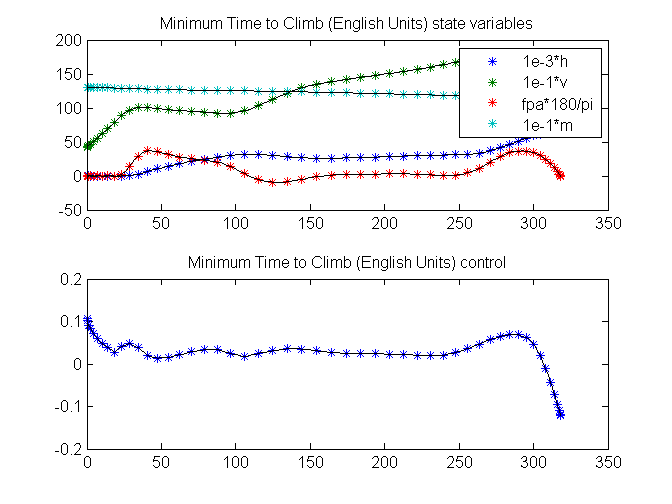PROPT Minimum Climb Time (English Units): Difference between revisions
From TomWiki
Jump to navigationJump to search
(Created page with "{{Part Of Manual|title=the PROPT Manual|link=PROPT Manual}} ==Problem description== Example about climbing (increase altitude) <source lang="matlab"> % Copyright ...") |
No edit summary |
||
| Line 1: | Line 1: | ||
{{Part Of Manual|title=the PROPT | {{Part Of Manual|title=the PROPT Manual|link=[[PROPT|PROPT Manual]]}} | ||
==Problem description== | ==Problem description== | ||
| Line 174: | Line 174: | ||
title('Minimum Time to Climb (English Units) control'); | title('Minimum Time to Climb (English Units) control'); | ||
</source> | </source> | ||
[[File:minimumClimbEng_01.png]] | |||
Revision as of 14:24, 2 November 2011
|
This page is part of the PROPT Manual. See PROPT Manual. |
Problem description
Example about climbing (increase altitude)
% Copyright (c) 2007-2008 by Tomlab Optimization Inc.Problem setup
alt0 = 0;
altf = 65600;
speed0 = 424.26;
speedf = 968.148;
fpa0 = 0;
fpaf = 0;
mass0 = 42000/32.208;
altmin = 0;
altmax = 69000;
speedmin = 10;
speedmax = 3000;
fpamin = -40*pi/180;
fpamax = -fpamin;
massmin = 50/32.208;
toms t t_f
p = tomPhase('p',t,0,t_f,50);
setPhase(p);
% Altitude, speed, flight path angle, mass
tomStates h v fpa m
% Angle of Attack
tomControls aalpha
guess = {
t_f == 300;
icollocate({
h == alt0 + t/t_f*(altf-alt0);
v == speed0 + t/t_f*(speedf-speed0);
fpa == 10*pi/180;
m == mass0;
})};
cbox = {
100 <= t_f <= 800;
collocate(-pi*20/180 <= aalpha <= pi/20*180)
icollocate(altmin <= h <= altmax)
icollocate(speedmin <= v <= speedmax)
icollocate(fpamin <= fpa <= fpamax)
icollocate(massmin <= m <= mass0)
};
bnd = {
initial(h) == alt0;
initial(v) == speed0;
initial(fpa) == fpa0;
initial(m) == mass0;
final(h) == altf;
final(v) == speedf;
final(fpa) == fpaf;
};
% US1976 data
hTab = (-2000:2000:86000);
rhoTab = [1.478 1.225 1.007 0.8193 0.6601 0.5258 0.4135 0.3119 ...
0.2279 0.1665 0.1216 0.08891 0.06451 0.04694 0.03426 0.02508 ...
0.01841 0.01355 0.009887 0.007257 0.005366 0.003995 0.002995 ...
0.002259 0.001714 0.001317 0.001027 0.0008055 0.0006389 0.0005044 ...
0.0003962 0.0003096 0.0002407 0.000186 0.0001429 0.0001091 ...
8.281e-005 6.236e-005 4.637e-005 3.43e-005 2.523e-005 1.845e-005 ...
1.341e-005 9.69e-006 6.955e-006];
sosTab = [347.9 340.3 332.5 324.6 316.5 308.1 299.5 295.1 295.1 ...
295.1 295.1 295.1 296.4 297.7 299.1 300.4 301.7 303 306.5 310.1 ...
313.7 317.2 320.7 324.1 327.5 329.8 329.8 328.8 325.4 322 318.6 ...
315.1 311.5 308 304.4 300.7 297.1 293.4 290.7 288 285.3 282.5 ...
279.7 276.9 274.1];
Mtab = [0; 0.2; 0.4; 0.6; 0.8; 1; 1.2; 1.4; 1.6; 1.8];
alttab = [0 5000 10000 15000 20000 25000 30000 40000 50000 70000];
Ttab = 1000*[24.2 24.0 20.3 17.3 14.5 12.2 10.2 5.7 3.4 0.1;
28.0 24.6 21.1 18.1 15.2 12.8 10.7 6.5 3.9 0.2;
28.3 25.2 21.9 18.7 15.9 13.4 11.2 7.3 4.4 0.4;
30.8 27.2 23.8 20.5 17.3 14.7 12.3 8.1 4.9 0.8;
34.5 30.3 26.6 23.2 19.8 16.8 14.1 9.4 5.6 1.1;
37.9 34.3 30.4 26.8 23.3 19.8 16.8 11.2 6.8 1.4;
36.1 38.0 34.9 31.3 27.3 23.6 20.1 13.4 8.3 1.7;
36.1 36.6 38.5 36.1 31.6 28.1 24.2 16.2 10.0 2.2;
36.1 35.2 42.1 38.7 35.7 32.0 28.1 19.3 11.9 2.9;
36.1 33.8 45.7 41.3 39.8 34.6 31.1 21.7 13.3 3.1];
M2 = [0 0.4 0.8 0.9 1.0 1.2 1.4 1.6 1.8];
Clalphatab = [3.44 3.44 3.44 3.58 4.44 3.44 3.01 2.86 2.44];
CD0tab = [0.013 0.013 0.013 0.014 0.031 0.041 0.039 0.036 0.035];
etatab = [0.54 0.54 0.54 0.75 0.79 0.78 0.89 0.93 0.93];
M = Mtab;
alt = alttab;
Re = 20902900;
mmu = 0.14076539e17;
S = 530;
g0 = 32.208;
ISP = 1600;
H = 23800;
rho0 = 0.002378;
rho = interp1(hTab,rhoTab,h*0.3048,'pchip')*0.001941;
sosI = interp1(hTab,sosTab,h*0.3048,'pchip')./0.3048;
Mach = v/sosI;
CD0 = interp1(M2,CD0tab,Mach,'pchip');
Clalpha = interp1(M2,Clalphatab,Mach,'pchip');
eta = interp1(M2,etatab,Mach,'pchip');
T = interp2(alttab, Mtab, Ttab, h, Mach, 'spline');
CD = CD0 + eta.*Clalpha.*aalpha.^2;
CL = Clalpha.*aalpha;
dynpres = 0.5.*rho.*v.^2;
D = dynpres.*S.*CD;
L = dynpres.*S.*CL;
equ = collocate({
dot(h) == v.*sin(fpa);
dot(v) == ((T.*cos(aalpha)-D)./m - mmu.*sin(fpa)./(Re+h).^2);
dot(fpa) == (T.*sin(aalpha)+L)./(m.*v)+cos(fpa).*(v./(Re+h)-mmu./(v.*(Re+h).^2));
dot(m) == -T./(g0.*ISP);
});
options = struct;
options.name = 'Minimum Time to Climb (English)';
options.scale = 'auto';Solve the problem
ezsolve(t_f,{cbox,bnd,equ},guess,options);Problem type appears to be: lpcon
Auto-scaling
Time for symbolic processing: 0.89551 seconds
Starting numeric solver
===== * * * =================================================================== * * *
TOMLAB - TOMLAB Development license 999007. Valid to 2011-12-31
=====================================================================================
Problem: --- 1: Minimum Time to Climb (English) f_k 318.348640855936940000
sum(|constr|) 0.000000000187118413
f(x_k) + sum(|constr|) 318.348640856124060000
f(x_0) 300.000000000000000000
Solver: snopt. EXIT=0. INFORM=1.
SNOPT 7.2-5 NLP code
Optimality conditions satisfied
FuncEv 1 ConstrEv 91 ConJacEv 90 Iter 49 MinorIter 2246
CPU time: 2.168414 sec. Elapsed time: 1.359000 sec.
Plot result
subplot(2,1,1)
ezplot([1e-3*h, 1e-1*v, fpa*180/pi, 1e-1*m])
legend('1e-3*h', '1e-1*v', 'fpa*180/pi', '1e-1*m');
title('Minimum Time to Climb (English Units) state variables');
subplot(2,1,2)
ezplot(aalpha);
title('Minimum Time to Climb (English Units) control');